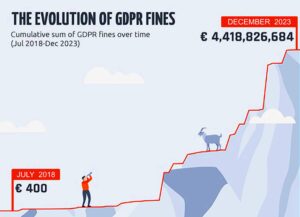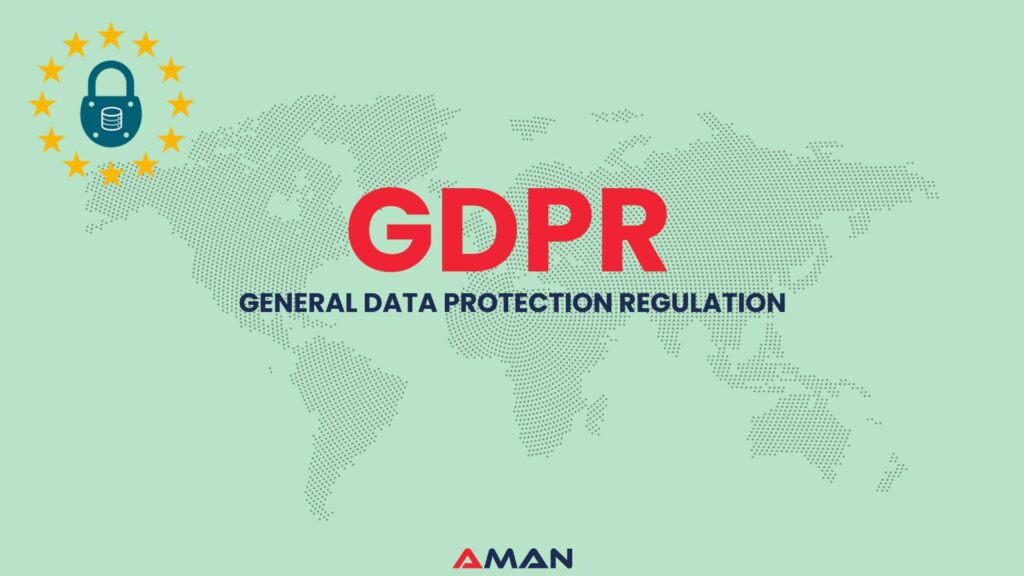A Saudi business expanding into Europe may face significant penalties under the General Data Protection Regulation (GDPR). For example, Amazon incurred an $887 million fine and Meta faced a $1.3 billion penalty. Since 2018, companies have paid more than $4.5 billion in GDPR penalties. These stories are not just headlines; they involve real businesses dealing with expensive data protection errors. The best approach is to learn from their experiences before expanding worldwide.
GDPR for Saudi businesses planning to grow internationally is not about being afraid. It is about preparing strategically. This guide looks at real penalty cases and explains how lessons from global compliance can help your organization compete more effectively.
What is GDPR?
Before diving into penalties and compliance strategies, let’s clarify what GDPR means. The General Data Protection Regulation (GDPR) is European Union legislation that came into effect on May 25, 2018. Think of it as the world’s most influential privacy law, one that changed how businesses globally handle personal data.
Here’s what makes GDPR different from previous privacy laws: it applies to any organization that processes the personal data of EU residents, regardless of the company’s location. So a Saudi company serving even one European customer falls under its scope.
GDPR covers any information that can identify a person, including:
- Names, email addresses, and phone numbers
- IP addresses and device identifiers
- Location data and online browsing behavior
- Financial information and purchase history
- Even employee data, if you have EU-based staff
What I find most significant about GDPR is its focus on individual rights. Unlike older privacy laws that mainly governed how companies should protect data, GDPR gives people specific rights over their personal information. This shift from company-centric to individual-centric privacy protection is what makes compliance both challenging and expensive when done wrong.
The regulation consists of 99 articles covering everything from consent requirements to data breach notifications. But don’t worry. You don’t need to memorize all of them. Understanding the core principles and requirements, which we’ll cover next, gives you the foundation for smart compliance planning.
The Global Reality: GDPR Penalties Reaching Record Heights

Recent data on General Data Protection Regulation (GDPR) enforcement from 2018 to 2023 reveal significant financial penalties imposed by regulatory authorities, raising substantial concerns for chief financial officers.
Major GDPR Enforcement Cases:
- Meta (Facebook): €1.2 billion(May 2023) for improper data transfers. The largest GDPR fine to date
- Amazon: €746 million(2021) for processing personal data without proper legal basis(For targeted advertising practices)
- TikTok (ByteDance): €345 million(2023) – A specific focus on its handling of children’s accounts(Mentioned as the third-largest fine)
- Uber: €290 million for transferring EU taxi drivers personal data
- WhatsApp: €225 million(2021) for transparency violations
- Google: €90 million(2021) for cookie consent issues
- H&M: €35.25 million for employee surveillance (Source)
But here’s what’s interesting: these aren’t just tech giants or large corporations getting hit. Companies from real estate, healthcare, and other sectors have also faced significant penalties. A German real estate company paid €14.5 million. A Portuguese hospital system faced €400,000 in fines. Even smaller organizations in diverse industries have received six-figure penalties.
Analysis of enforcement data over several years indicates that the frequency and magnitude of penalties have not diminished. In 2023, GDPR fines exceeded €2.1 billion globally. Initial regulatory actions have transitioned into consistent enforcement with substantial financial consequences.
This trend demonstrates that GDPR enforcement has become a standard aspect of business operations across Europe. Regulatory authorities are increasingly imposing penalties that have a significant impact on organizational finances.
When Saudi Businesses Enter the GDPR Zone
You may be considering, “Our company operates in Saudi Arabia. Does European regulation really impact us?” Many international companies had the same thought until penalty notices arrived.
Here’s when GDPR applies to your Saudi business:
Digital Market Expansion: If you plan to serve European customers through e-commerce, SaaS platforms, or digital services, you’re in GDPR territory. Even one European customer downloading your app or making a purchase triggers compliance requirements.
International Partnerships: Many Saudi companies partner with European businesses for technology, consulting, or joint ventures. When personal data gets shared in these relationships, GDPR rules apply to both parties.
Cloud and Technology Services: Using international cloud providers that process data in European data centers can create GDPR obligations. This includes popular services like AWS, Google Cloud, or Microsoft Azure with EU regions.
Marketing and Lead Generation: Running digital advertising campaigns that target European audiences or collect email addresses from European visitors puts you under the GDPR scope.
Future Growth Plans: Smart businesses prepare for compliance before expansion, not after penalty notices arrive.
I’ve consulted with Saudi companies that discovered their GDPR exposure only when preparing for Series B funding. European investors now routinely ask about data protection compliance during due diligence. Being prepared opens doors; being caught off-guard closes them.
Understanding the Financial Stakes: Penalty Structure Explained
Let’s break down how these million-dollar penalties are calculated, because understanding the math clarifies your real financial exposure.
GDPR’s Two-Tier System:
- Tier 1: Up to €10 million or 2% of global annual turnover (whichever is higher)
- Tier 2: Up to €20 million or 4% of global annual turnover (whichever is higher)
It is essential to note that the term “global” refers to the entirety of your worldwide revenue as the calculation base, rather than just your European operations.
Real Example Breakdown: Consider a company with annual revenue of $500 million planning expansion into Europe. A significant GDPR violation could, in theory, result in penalties of up to $20 million (representing 4% of $500 million). Even a less severe violation could incur penalties of $10 million (2% of revenue).
Several factors influence the determination of penalty amounts, based on a review of regulatory decisions:
- Intentional vs Negligent: Organizations that knowingly violate regulations are subject to higher penalties.
- Cooperation Level: Organizations that resist investigations get hit harder
- Data Volume: More personal data affected means bigger fines
- Sensitive Data: Violations involving health, financial, or children’s data typically incur higher penalties.
- Previous Violations: Repeat offenders face escalating consequences
- Mitigation Efforts: Quick response and remediation can reduce penalties
In practice, even relatively minor GDPR penalties frequently exceed $100,000. For context, this amount is comparable to the annual salary costs of employing three to four additional cybersecurity professionals. This underscores that investing in preventive measures is financially preferable to incurring regulatory penalties.
Million-Dollar Mistakes
A review of hundreds of GDPR penalty cases reveals clear patterns: specific violations repeatedly drive the highest fines. Here are the critical, high-cost lessons every executive should know.
Mistake #1: Relying on Blanket Consent. Many organizations operated under the illusion that broad consent provided lasting coverage. Meta’s $1.2 billion fine highlighted the risk of outdated consent models. Consent must be explicit, informed, and continuously validated.
Mistake #2: Treating Data Transfers Casually. International data transfers have generated some of the largest penalties. Companies assumed standard contracts provided adequate protection, only to discover they needed additional safeguards. This particularly affects Saudi businesses using international cloud services or sharing data with global partners.
Mistake #3: Ignoring Data Subject Rights. Amazon’s massive fine stemmed partly from making it difficult for customers to access and control their personal data. Many companies built systems that collected data efficiently but struggled to provide transparency or deletion capabilities.
Mistake #4: Poor Incident Response. Under GDPR, you have 72 hours to notify authorities about data breaches. Companies that missed this deadline or provided incomplete notifications faced additional penalties on top of the original violation.
Mistake #5: Inadequate Privacy by Design. Building privacy protections after launching products proved extremely costly. Companies that treated privacy as an afterthought faced both technical debt and regulatory penalties.
What strikes me most about these cases is how preventable they were. These weren’t companies trying to break rules. They were businesses that made assumptions about data protection without fully understanding the requirements.
The expensive pattern I see repeatedly: companies that approach GDPR reactively instead of proactively consistently face higher penalties and operational disruption.
What are the 7 GDPR Requirements?
Now that we understand what causes million-dollar penalties, let’s break down the core requirements that every Saudi business needs to know. I’ve distilled GDPR into 7 essential requirements that form the backbone of compliance:
- Lawful Basis for Processing. You need a legal reason to process personal data. The most common bases include consent, contract fulfillment, legal obligations, vital interests, public tasks, or legitimate interests. Many Saudi companies rely too heavily on consent when other bases might be more appropriate for their business model.
- Data Minimization and Purpose Limitation. Collect only the personal data you need and use it solely for the specified purposes. Data minimization limits collection to essential information, while purpose limitation means using data only for the reasons originally specified. I’ve seen companies get into trouble by gathering extensive customer information “just in case,” but that violates GDPR principles.
- Transparency and individual rights are crucial. People must know what data you collect and why. You must honor their rights to access (view their information), correct (fix errors), delete (remove their information), or port (transfer their data to another service) their data. This requires building systems that quickly respond to such requests, not just collect data efficiently.
- Data Security and Protection are essential. Implement appropriate technical and organizational security measures. This isn’t just about preventing breaches; it’s about demonstrating that you’ve made reasonable efforts to protect personal data throughout its lifecycle.
- Accountability and Documentation. You must be able to demonstrate compliance, not just achieve it. This means maintaining detailed records of your data processing activities, privacy assessments, and compliance measures. Think of it as building an audit trail for regulators.
- Data Breach Notification. Report serious data breaches to authorities within 72 hours and notify affected individuals when the breach poses high risks to their rights. Many companies underestimate how complex breach assessment and notification can be under pressure.
- Privacy by Design and Default. Integrate data protection measures and privacy safeguards during system development, not afterward. Configure your products and services so users’ information is protected automatically, without extra steps. Many companies struggle here; retrofitting privacy into existing systems costs much more than building it in from the start.
In summary, these seven requirements form the foundation of every successful GDPR compliance program I’ve helped implement. The companies that master these fundamentals rarely face serious penalties.
Smart Preparation: Building GDPR-Ready Operations
Based on successful compliance implementations I’ve observed, here’s how forward-thinking Saudi businesses are preparing for GDPR requirements:
Phase 1: Assessment and Foundation (Month 1-2)
Start with a data audit. Map where personal data flows in your organization, from customer onboarding to marketing automation and customer support. Many companies discover they’re processing more personal data than they realized.
Define clear data processing purposes. GDPR requires specific, legitimate reasons to process personal data. Avoid vague purposes such as “business operations.”
Phase 2: Technical Implementation (Month 2-4)
Build privacy into your systems. Collect only necessary data, manage consent properly, and enable user data access through dashboards.
Implement strong data security. Encrypt data at rest and in transit, use access controls, and perform regular security assessments. Treat security as a legal requirement, not just a best practice.
Phase 3: Process and Training (Month 3-5)
Establish incident response procedures. Prepare to detect, assess, and report breaches within required timeframes.
Train your team on privacy principles. Ensure everyone who handles data understands their responsibilities and the risks of violations.
Phase 4: Documentation and Monitoring (Month 4-6)
Create detailed documentation of your data processing activities. GDPR requires organizations to demonstrate compliance, not just achieve it.
Monitor and assess compliance regularly. Treat privacy as an ongoing commitment, not a one-time project.
Investment Perspective: A typical GDPR compliance project for a mid-size Saudi company costs $150,000-$300,000 in the first year. Potential penalties start at millions of dollars. From an ROI perspective, compliance investment makes sense.
More importantly, many companies discover that building proper data governance actually improves their operations. Better data management often leads to more effective marketing, improved customer insights, and stronger security posture.
How Does GDPR Fit into the Data Governance Framework?
GDPR is a cornerstone of effective data governance. For Saudi businesses, understanding how GDPR fits into the bigger picture transforms compliance from a checkbox exercise into part of managing data as a strategic asset.
Data governance can be viewed as a pyramid structure:
Foundation Level: Data Infrastructure This includes your databases, cloud storage, data pipelines, and security systems. GDPR requirements for data security and breach notification sit at this foundational level. Without a solid data infrastructure, compliance becomes nearly impossible.
Management Level: Policies and Processes. Most GDPR requirements are here: data processing policies, consent management, rights response, and privacy impact assessments. This level turns GDPR requirements into business processes.
Strategic Level: Data as Business Asset. At the top, data governance aligns data management with business objectives. GDPR compliance here means using privacy protection as a competitive advantage and building customer trust through transparent data practices. The key takeaway: GDPR moves privacy from a compliance task to a strategic business benefit.
Where GDPR Adds Value to Data Governance:
Quality Improvement: GDPR’s data minimization forces you to assess what data you actually need, often surfacing quality issues and unnecessary collection.
Risk Management: Privacy impact assessments required by GDPR help identify broader data risks that might not be obvious in traditional risk assessments.
Customer Relations: GDPR’s emphasis on transparency and individual rights often improves customer communication and builds stronger relationships based on trust.
Operational Efficiency: Building systems for data subject requests often exposes inefficiencies in data storage or retrieval processes. Addressing these issues streamlines operations and delivers lasting organizational benefits.
Turn Global Lessons into Local Advantage
The global GDPR penalty scenario tells a clear story: data protection compliance has evolved from an optional best practice to essential business requirement. Companies worldwide have paid billions learning this lesson the expensive way.
For Saudi businesses aiming for international growth, now is the time to act. While competitors deal with costly, reactive compliance after expanding into European markets, you have a window to build privacy-ready operations from the start.
The strategic advantage goes beyond avoiding penalties. European customers increasingly prefer businesses that demonstrate strong privacy practices. Investors look for companies with proper data governance. Partners want to work with organizations that won’t create regulatory liability.
Your Next Steps:
- Assess Your Current Exposure: Review your business model, customer base, and technology stack to identify potential GDPR triggers
- Set Your Compliance Timeline: If you plan to expand into Europe, start preparations immediately. Delays can be costly
- Build Privacy into Growth Plans: Make data protection a consideration in product development, marketing strategies, and partnership decisions
- Consider Professional Guidance: Complex regulations benefit from expert interpretation, especially when penalties reach millions of dollars
Final Thought
Companies that thrive globally are those that see privacy compliance as a competitive advantage, not a regulatory burden. Saudi businesses can learn from global lessons and establish practices that support sustainable international growth.
Act now: prepare your business for GDPR compliance, avoid costly missteps, and position yourself as a market leader.





